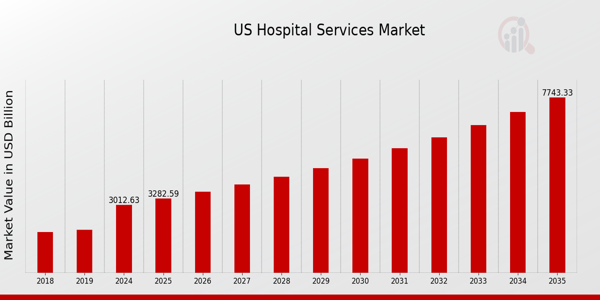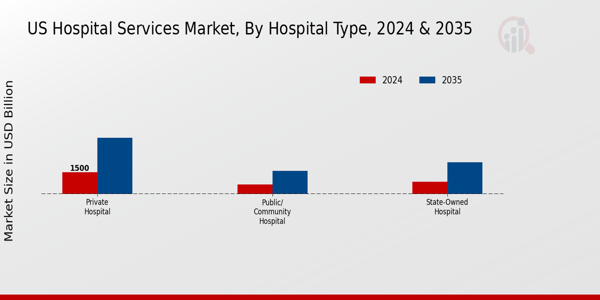US Hospital Services Market Overview
As per MRFR analysis, the US Hospital Services Market Size was estimated at 2,774.06 (USD Billion) in 2023. The US Hospital Services Market Industry is expected to grow from 3,012.63 (USD Billion) in 2024 to 7,743.25 (USD Billion) by 2035. The US Hospital Services Market CAGR (growth rate) is expected to be around 8.961% during the forecast period (2025 - 2035).
Key US Hospital Services Market Trends Highlighted
The US Hospital Services Market is experiencing several important trends driven by changing healthcare demands and advancements in technology. One key market driver is the increasing emphasis on patient-centered care, which is pushing hospitals to enhance service delivery and improve overall patient experience.
Healthcare facilities are investing in modern technologies such as telemedicine, electronic health records, and patient management systems, which facilitate better access to healthcare services and improve efficiency in hospital operations. Additionally, there is a significant focus on value-based care, which incentivizes hospitals to prioritize outcomes rather than the volume of services provided.
This shift encourages the adoption of evidence-based practices and technologies that lower hospital readmission rates and improve patient outcomes. The rise of chronic diseases among the US population further propels the need for comprehensive hospital services and integrated care solutions.
Recent times have also seen trends towards greater collaboration among healthcare providers. Hospitals are forming partnerships with outpatient facilities and community organizations to extend their services beyond traditional settings. This trend allows for more coordinated care, enhancing population health management and addressing social determinants of health.
Opportunities to explore include expanding telehealth services as patient demand for remote care continues to grow. The ongoing integration of artificial intelligence and big data analytics in hospital services also presents potential for improved operational efficiencies and personalized patient care. With heightened focus on healthcare accessibility, US hospitals are eager to leverage these emerging trends while navigating regulatory landscapes and evolving patient expectations.

Source: Primary Research, Secondary Research, Market Research Future Database and Analyst Review
US Hospital Services Market Drivers
Increasing Demand for Hospital Services due to Aging Population
The United States is experiencing a significant increase in its aging population, which is a key driver for the US Hospital Services Market Industry. By 2030, it is estimated that around 20 percent of the U.S. population will be 65 years or older. This demographic shift will lead to a higher prevalence of chronic diseases such as heart disease, diabetes, and arthritis, increasing the demand for hospital services, including emergency care and surgical procedures.
Studies from the U.S. Census Bureau indicate that as this age group continues to grow, healthcare facilities will need to adapt their services accordingly to meet the needs of older adults. Established organizations such as the American Hospital Association (AHA) are recognizing these trends, pushing for enhanced resources and policies that cater specifically to the older population, which in turn significantly boosts the growth potential of the US Hospital Services Market.
Technological Advancements in Healthcare
Technological advancements such as telemedicine, robotic surgeries, and electronic health records are major drivers altering the landscape of the US Hospital Services Market Industry. Telehealth utilization soared during the COVID-19 pandemic, with studies showing a 154 percent increase in telehealth visits during the last week of March 2020 compared to the previous year according to the Centers for Medicare & Medicaid Services (CMS).
This surge in technology adoption not only improves patient care but also expands accessibility, resulting in a greater utilization of hospital services. Innovators and well-established hospitals in the U.S. are integrating these technologies into their systems, thereby facilitating a more efficient service delivery model.
Rise in Chronic Diseases
The United States is witnessing a pronounced rise in chronic diseases such as obesity, diabetes, and cardiovascular diseases, which are significant drivers for the US Hospital Services Market Industry. The Centers for Disease Control and Prevention (CDC) reports that seven out of ten deaths among Americans are caused by chronic diseases.
Moreover, chronic disease prevalence has increased significantly, with the CDC noting that 42.4 percent of adults are classified as obese. This alarming trend necessitates more advanced and frequent hospital services, from preventative care to surgical interventions and long-term treatment. Notable health organizations are increasingly focusing on strategies to manage and mitigate the impact of these conditions, further propelling the growth of the hospital services market.
US Hospital Services Market Segment Insights
Hospital Services Market Hospital Type Insights
The US Hospital Services Market, particularly within the Hospital Type segment, reflects a diverse landscape characterized by various operational structures that together fulfill a vital role in delivering healthcare services throughout the country. State-owned hospitals represent a crucial component of this ecosystem, typically funded and operated by government entities, providing care to underserved populations and functioning as key providers in public health emergencies.
These facilities often exhibit a high capacity for various medical services, supported by government budgets, which allows them to maintain critical services amidst economic fluctuations. Private hospitals, on the other hand, play a significant role by catering to the demands of patients who seek elective and specialized care in settings that often emphasize comfort and convenience.
These establishments are driven by a profit motive, and due to their operational flexibility, they can rapidly adopt new technologies and innovations, enabling them to offer advanced medical treatments and facilities. In the case of public or community hospitals, these institutions predominantly focus on delivering essential healthcare services with the mission of providing equal access for all community residents, irrespective of their financial situation.
Community hospitals are vital to addressing local health needs; they often serve as the first point of contact for primary care and are well-integrated into public health initiatives, reflecting the US health system's commitment to accessibility and preventive care. The segmentation of the US Hospital Services Market by type not only mirrors the vast array of healthcare needs but also highlights the intricate interplay between various hospital types in addressing public health priorities.
As factors like population aging and increasing disease prevalence exert continuous pressure on the healthcare ecosystem, the need for each hospital type will evolve, prompting ongoing innovation and expansion. Furthermore, the rise of consumer-driven healthcare necessitates that hospitals across all types adopt patient-centered approaches while navigating challenges like regulatory pressures, funding constraints, and the ongoing need for technological investments.
Each of these hospital types contributes significantly to the overall healthcare delivery model in the US, ensuring that the system remains multifaceted and responsive to the diverse needs of its population, thereby underscoring the importance of the Hospital Type segmentation in understanding the broader US Hospital Services Market dynamics.

Source: Primary Research, Secondary Research, Market Research Future Database and Analyst Review
Hospital Services Market Service Type Insights
The US Hospital Services Market has seen significant growth and diversification, particularly in relation to its Service Type segment, which includes key areas such as Outpatient Services and Inpatient Services. Outpatient Services have gained prominence due to the increasing preference for less invasive procedures and the growing focus on cost-effectiveness in healthcare delivery, making them a vital component in the market's structure.
Conversely, Inpatient Services continue to play an essential role, especially in managing complex health conditions that require extensive care and prolonged treatment within hospital settings. The demand for these inpatient services often arises from an aging population, and chronic conditions, reflecting a shift towards more substantial institutional care.
This duality in service provision illustrates how the US Hospital Services Market segmentation caters to a broad spectrum of patient needs, thereby enhancing the overall healthcare experience. Trends toward integrated care systems and advancements in medical technology are expected to further propel growth in both areas, shaping the future of healthcare in the United States.
Overall, the Service Type segment remains critical in addressing the evolving healthcare landscape, aligning with the push for more accessible and efficient hospital services.
Hospital Services Market Service Areas Insights
The US Hospital Services Market focuses significantly on various Service Areas critical to healthcare delivery, capitalizing on advancements in technology and patient needs. The cardiovascular segment stands out as a vital area due to the increasing prevalence of heart-related diseases, promoting innovative surgical techniques and diagnostic tools.
Acute care remains essential, catering to patients requiring immediate medical attention, reflecting a trend towards quick response times and integrated care systems. Cancer care focuses on comprehensive treatment pathways, employing advanced therapies and personalized medicine, which is crucial given the rising cancer incidence in the US.
Additionally, the diagnostics and imaging services are pivotal, enhancing early detection and patient outcomes through advanced imaging technologies and laboratory services. Neurorehabilitation and psychiatry services play an important role in addressing the mental health crisis, with effective treatment programs being developed to support recovery and patient management.
Gynecology continues to evolve with increased awareness and advocacy for women's health, aiming to improve services and outreach. Lastly, other services encompass a wide range of specialties, enriching the hospital’s capacity to meet diverse patient needs. This multi-faceted approach signifies the adaptability and comprehensiveness of the US Hospital Services Market as it evolves with changing healthcare demands.
US Hospital Services Market Key Players and Competitive Insights
The US Hospital Services Market is characterized by a highly competitive landscape marked by intense rivalry among various providers, each vying for market share and a strong foothold in an ever-evolving healthcare environment. With a multitude of players offering a wide array of services ranging from inpatient care to specialized treatments, hospitals are constantly innovating to enhance patient outcomes and drive operational efficiency.
The market is influenced by factors such as advancements in medical technology, regulatory changes, patient expectations, and an increasing focus on value-based care. As a result, understanding the competitive dynamics is essential for stakeholders looking to navigate this multifaceted sector effectively.
Health First operates as a prominent entity within the US Hospital Services Market, showcasing various strengths that contribute to its competitive positioning. The organization emphasizes a comprehensive approach to healthcare, integrating services that encompass prevention, treatment, and rehabilitation.
With its organizational structure built around patient-centered care, Health First has established a strong reputation for quality service delivery, bolstered by its focus on technological advancements and workforce development. Its presence in multiple regions enables it to leverage economies of scale, enhance operational efficiencies, and cater to diverse patient populations effectively, positioning Health First as a strong competitor within the market.
Ascension Health stands out in the US Hospital Services Market through its extensive array of health services and innovative care models. As a leading nonprofit healthcare system, Ascension Health delivers a wide range of services, including acute care, outpatient services, and specialty hospitals, facilitating comprehensive patient care.
The organization's strength lies in its commitment to community-focused solutions, solidifying its market presence through partnerships and strategic collaborations. Furthermore, Ascension Health has engaged in key mergers and acquisitions to expand its footprint and enhance service offerings while ensuring operational efficiency.
With an emphasis on improving health outcomes through data-driven insights and enhanced patient engagement, Ascension Health continues to reinforce its position as a key player in the competitive landscape of hospital services in the US.
Key Companies in the US Hospital Services Market Include
- Baylor Scott and White Health
- Universal Health Services
US Hospital Services Market Industry Developments
The US Hospital Services Market has seen significant developments recently, particularly in its expansion and acquisitions among major entities. Notably, in August 2023, Tenet Healthcare announced a collaboration with University of California San Diego Health to enhance integrated care services, aiming to improve patient outcomes.
Community Health Systems reported growth in admissions in October 2023, reflecting recovery post-pandemic, which has further bolstered the market's viability. Furthermore, HCA Healthcare is actively expanding its footprint, with recent investments in technology and facilities aimed at enhancing patient care.
In terms of mergers and acquisitions, in September 2023, Ascension Health finalized its acquisition of a local health system to broaden its service offerings across various regions, increasing its market share. Concurrently, Banner Health has been focusing on expanding telehealth services to meet rising demand.
Additionally, the Centers for Medicare and Medicaid Services have announced new reimbursement models to support hospitals in offering value-based care, which will influence operational strategies across the market. These movements highlight a trend towards technological integration and improved patient care frameworks within the US Hospital Services Market, shaping its future landscape.
US Hospital Services Market Segmentation Insights
Hospital Services Market Hospital Type Outlook
- Public/ Community Hospital
Hospital Services Market Service Type Outlook
Hospital Services Market Service Areas Outlook
- Neurorehabilitation & Psychiatry Services
| Report Attribute/Metric Source: |
Details |
| MARKET SIZE 2018 |
2774.06(USD Billion) |
| MARKET SIZE 2024 |
3012.63(USD Billion) |
| MARKET SIZE 2035 |
7743.25(USD Billion) |
| COMPOUND ANNUAL GROWTH RATE (CAGR) |
8.961% (2025 - 2035) |
| REPORT COVERAGE |
Revenue Forecast, Competitive Landscape, Growth Factors, and Trends |
| BASE YEAR |
2024 |
| MARKET FORECAST PERIOD |
2025 - 2035 |
| HISTORICAL DATA |
2019 - 2024 |
| MARKET FORECAST UNITS |
USD Billion |
| KEY COMPANIES PROFILED |
Health First, Ascension Health, Community Health Systems, HCA Healthcare, Froedtert Health, Baylor Scott and White Health, WellSpan Health, Mayo Clinic, Tenet Healthcare, Cleveland Clinic, Universal Health Services, Banner Health, Kaiser Permanente, Trinity Health, CHRISTUS Health |
| SEGMENTS COVERED |
Hospital Type, Service Type, Service Areas |
| KEY MARKET OPPORTUNITIES |
Telehealth expansion, Aging population services, Medical device integration, Value-based care models, Personalized medicine advancements |
| KEY MARKET DYNAMICS |
rising healthcare expenditure, technological advancements, increasing patient expectations, regulatory compliance pressures, growing prevalence of chronic diseases |
| COUNTRIES COVERED |
US |
Frequently Asked Questions (FAQ):
The US Hospital Services Market is expected to be valued at 3012.63 USD Billion in 2024.
By 2035, the market is anticipated to reach a value of 7743.25 USD Billion.
The expected Compound Annual Growth Rate (CAGR) for the market from 2025 to 2035 is 8.961 percent.
Private hospitals are valued at 1500.0 USD Billion in the US Hospital Services Market for the year 2024.
State-owned hospitals are projected to reach a value of 2216.0 USD Billion by 2035.
Major players include Health First, Ascension Health, HCA Healthcare, and Mayo Clinic among others.
Public/community hospitals are valued at 662.63 USD Billion in the year 2024.
Emerging trends and technological advancements present significant growth opportunities in the market.
The market faces challenges such as regulatory changes and rising operational costs affecting growth.
Growth rates may vary significantly among state-owned, private, and public hospitals, influenced by varying demand dynamics.















